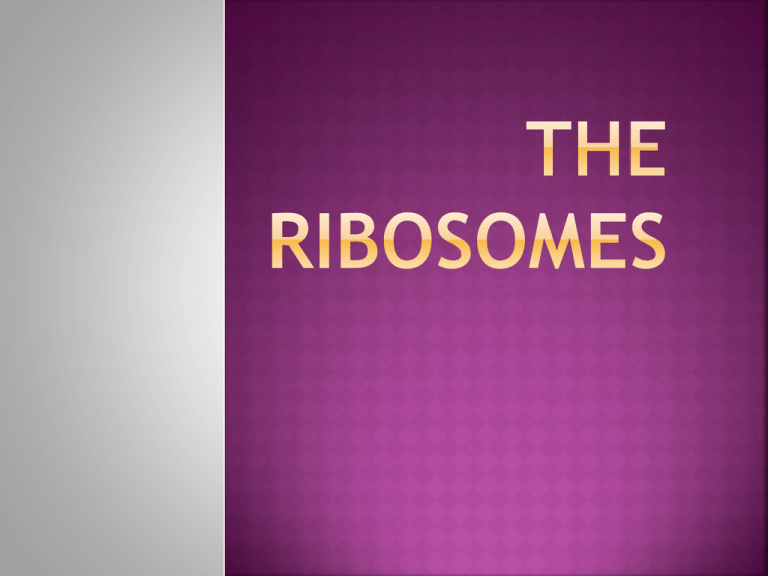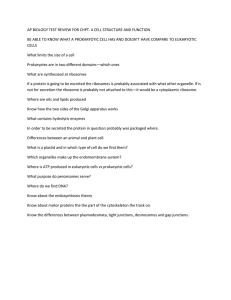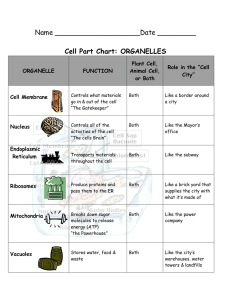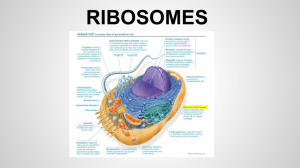Ribosomes 10
advertisement

Ribosomes were first observed as dense particle granules in the mid1950s by Romanian cell biologist George Emil Palade using an EM. Palade in I974 won a Nobel Prize on this discovery The term "ribosome" was proposed by Richard B. Roberts in 1958. The ribosome (from ribonucleic acid and the Greek soma, meaning "body") is a large and complex molecular machine, found within all living cells Venkartraman Ramakrishnan, Thomas A. Steitz and Ada E. Yonath won the Nobel prize in 2009 for determining the detailed molecular structure and mechanism of action of the ribosome. Ribosome is made of rRNA and proteins It serves as the primary site of biological protein synthesis (translation). The cell that have high rate of protein synthesis have large number of ribosome. i.e. human pancrease cells Cells active in protein synthesis have large nucleoli. Ribosome link amino acids together by catalyticpeptidyl transferase activity in the order specified by messenger RNA (mRNA) molecules, thus known ribozyme. Ribosome consist of two major subunits—the small ribosomal subunit reads the mRNA, while the large subunit joins amino acids to form a polypeptide chain. Each subunit is composed of one or more ribosomal RNA (rRNA) molecules and a variety of proteins. The ribosome and associated molecules (tRNA & AAS) are also known as the translational apparatus. Ribosomes of bacteria, archaea and eukaryotes differ in their size, sequence, structure, and the ratio of protein to RNA. The differences in structure allow some antibiotics to kill bacteria by inhibiting their ribosomes, while leaving human ribosomes unaffected Ribosomes are free (cytoplasm) or bound (associated with membranes) of Endoplasmic Reticulum. Ribosomes consist of two subunits of non-equal size; longer in axis than in diameter that fit together and work as one to translate the mRNA into a polypeptide chain during protein synthesis. Prokaryotic ribosomes are around 20 nm (200 Å) in diameter and are composed of 65% rRNA and 35% ribosomal proteins. Eukaryotic ribosomes are between 25 and 30nm (250– 300 Å) in diameter and the ratio of rRNA to protein is close to 1. In bacteria ribosomal subunits consist of one or two and in eukaryotes one or three very large RNA molecules (known as rRNA) and multiple smaller protein molecules. Crystallographic work has shown that the protein components of ribosomes do not directly participate in peptide bond formation catalysis, but rather suggests that these proteins act as a scaffold that may enhance the ability of rRNA to synthesize protein. The unit of measurement of ribosomal units is Svedberg unit, a measure of the rate of sedimentation in centrifugation rather than size, and this accounts for why fragment names do not add up (70S is made of 50S and 30S). Prokaryotes have 70S ribosomes, each consisting of a small (30S) and a large (50S) subunit. Small subunit has a 16S RNA subunit (consisting of 1540 nucleotides) bound to 21 proteins. The large subunit is composed of a 5S RNA subunit (120 nucleotides), a 23S RNA subunit (2900 nucleotides) and 31proteins. Affinity label for the tRNA binding sites on the E. coli ribosome allowed the identification of A and P site proteins most likely associated with the peptidyltransferase activity; labeled proteins are L27, L14, L15, L16, L2; at least L27 is located at the donor site. The S1 and S21 proteins, in association with the 3'-end of 16S ribosomal RNA, are involved in the initiation of translation Eukaryotes have 80S ribosomes, each consisting of a small (40S) and large (60S) subunit. The 40S subunit has an 18S RNA (1900 nucleotides) and 33 proteins. The large subunit is composed of a 5S RNA (120 nucleotides), 28S RNA (4700 nucleotides), a 5.8S RNA (160 nucleotides) subunits and 46 proteins. The affinity labeling studies identify tRNA-binding sites on rat liver ribosomes. Several proteins, including L32/33, L36, L21, L23, L28/29 and L13 were near the Peptidyl transferase (P) center. The ribosomes of chloroplasts and mitochondria of eukaryotes also consist of large and small subunits bound together with proteins into one 70S particle. These organelles are believed to be descendants of bacteria and as such their ribosomes are similar to those of bacteria. Pharmaceutical chemists developed an antibiotic that can destroy a bacterial infection without harming the cells of the infected person. Due to the differences in their structures, the bacterial 70S ribosomes are vulnerable to these antibiotics while the eukaryotic 80S ribosomes are not Even though mitochondria possess ribosomes similar to the bacterial ones, but they are not affected by these antibiotics because of double membrane which does not easily admit antibiotics into the organelle. Ribosomes are the workhorses of protein synthesis, the process of translating mRNA into protein. The mRNA comprises a series of codons that dictate to the ribosome the sequence of the amino acids needed to make the protein. Using the mRNA as a template, the ribosome traverses each codon (3 nucleotides) of the mRNA, pairing it with the appropriate amino acid provided by an aminoacyl-tRNA. Aminoacyl-tRNA contains a complementary anticodon on one end and the appropriate amino acid on the other. The small ribosomal subunit, bound to an aminoacyl-tRNA containing the amino acid methionine, binds to an AUG codon on the mRNA and recruits the large ribosomal subunit. The ribosome contains three RNA binding sites, designated A, P and E. The A site binds an aminoacyl-tRNA; the P site binds a peptidyl-tRNA; and the E site binds a free tRNA before it exits the ribosome. Protein synthesis begins at a start codon AUG near the 5' end of the mRNA. mRNA binds to the P site of the ribosome first. The ribosome is able to identify the start codon by use of the ShineDalgarno sequence of the mRNA in prokaryotes and Kozak box in eukaryotes. Ribosomes are of two types: free (cytoplasm) and membrane bound (associated with ER) Free or membrane-bound state depends on the presence of an ER-targeting signal sequence on the protein being synthesized Ribosomes are sometimes referred to as non-membranous organelle. Free ribosomes: Free ribosomes can move about anywhere in the cytosol, but are excluded from the cell nucleus and other organelles. Proteins that are formed from free ribosomes are released into the cytosol and used within the cell. Membrane-bound ribosomes: When a ribosome begins to synthesize proteins that are needed in some organelles, the ribosome making this protein can become "membrane-bound". In eukaryotic cells this happens in a region of the endoplasmic reticulum (ER) called the "rough ER". The newly produced polypeptide chains are inserted directly into the ER by the ribosome undertaking vectorial synthesis and are then transported to their destinations, through the secretory pathway. Bound ribosomes usually produce proteins that are used within the plasma membrane or are expelled from the cell (exocytosis)




